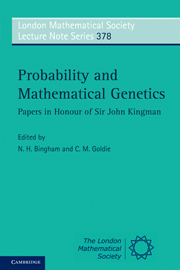Book contents
- Frontmatter
- Contents
- List of contributors
- Preface
- Bibliography of J. F. C. Kingman
- 1 A fragment of autobiography, 1957–1967
- 2 More uses of exchangeability: representations of complex random structures
- 3 Perfect simulation using dominated coupling from the past with application to area-interaction point processes and wavelet thresholding
- 4 Assessing molecular variability in cancer genomes
- 5 Branching out
- 6 Kingman, category and combinatorics
- 7 Long-range dependence in a Cox process directed by an alternating renewal process
- 8 Kernel methods and minimum contrast estimators for empirical deconvolution
- 9 The coalescent and its descendants
- 10 Kingman and mathematical population genetics
- 11 Characterizations of exchangeable partitions and random discrete distributions by deletion properties
- 12 Applying coupon-collecting theory to computer-aided assessments
- 13 Colouring and breaking sticks: random distributions and heterogeneous clustering
- 14 The associated random walk and martingales in random walks with stationary increments
- 15 Diffusion processes and coalescent trees
- 16 Three problems for the clairvoyant demon
- 17 Homogenization for advection-diffusion in a perforated domain
- 18 Heavy traffic on a controlled motorway
- 19 Coupling time distribution asymptotics for some couplings of the Lévy stochastic area
- 20 Queueing with neighbours
- 21 Optimal information feed
- 22 A dynamical-system picture of a simple branching-process phase transition
- Index
22 - A dynamical-system picture of a simple branching-process phase transition
Published online by Cambridge University Press: 07 September 2011
- Frontmatter
- Contents
- List of contributors
- Preface
- Bibliography of J. F. C. Kingman
- 1 A fragment of autobiography, 1957–1967
- 2 More uses of exchangeability: representations of complex random structures
- 3 Perfect simulation using dominated coupling from the past with application to area-interaction point processes and wavelet thresholding
- 4 Assessing molecular variability in cancer genomes
- 5 Branching out
- 6 Kingman, category and combinatorics
- 7 Long-range dependence in a Cox process directed by an alternating renewal process
- 8 Kernel methods and minimum contrast estimators for empirical deconvolution
- 9 The coalescent and its descendants
- 10 Kingman and mathematical population genetics
- 11 Characterizations of exchangeable partitions and random discrete distributions by deletion properties
- 12 Applying coupon-collecting theory to computer-aided assessments
- 13 Colouring and breaking sticks: random distributions and heterogeneous clustering
- 14 The associated random walk and martingales in random walks with stationary increments
- 15 Diffusion processes and coalescent trees
- 16 Three problems for the clairvoyant demon
- 17 Homogenization for advection-diffusion in a perforated domain
- 18 Heavy traffic on a controlled motorway
- 19 Coupling time distribution asymptotics for some couplings of the Lévy stochastic area
- 20 Queueing with neighbours
- 21 Optimal information feed
- 22 A dynamical-system picture of a simple branching-process phase transition
- Index
Summary
Abstract
This paper proves certain results from the ‘appetizer for non-linear Wiener–Hopf theory’ [5]. Like that paper, it considers only the simplest possible case in which the underlying Markov process is a two-state Markov chain. Key generating functions provide solutions of a simple two-dimensional dynamical system, and the main interest is in the way in which Probability Theory and ODE theory complement each other. No knowledge of either ODE theory or Wiener–Hopf theory is assumed. Theorem 1.1 describes one aspect of a phase transition which is more strikingly conveyed by Figures 4.1 and 4.2.
AMS subject classification (MSC2010) 60J80, 34A34
Introduction
This paper is a development of something I mentioned briefly in talks I gave at Bristol, when John Kingman was in the audience, and at the Waves conference in honour of John Toland at Bath. I thanked both John K and John T for splendid mathematics and for their wisdom and kindness.
The main point of the paper is to prove Theorem 1.1 and related results in a way which emphasizes connections with a simple dynamical system. The phase transition between Figures 4.1 and 4.2 looks more dramatic than the famous 1-dimensional result we teach to all students.
The model studied here is a special case of the model introduced in Williams [5]. I called that paper, which contained no proofs, an ‘appetizer’; but before writing a fuller version, I became caught up in Jonathan Warren's enthusiasm for the relevance of complex dynamical systems (in ℂ2).
Information
- Type
- Chapter
- Information
- Probability and Mathematical GeneticsPapers in Honour of Sir John Kingman, pp. 491 - 508Publisher: Cambridge University PressPrint publication year: 2010
